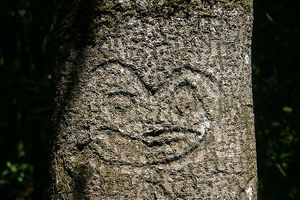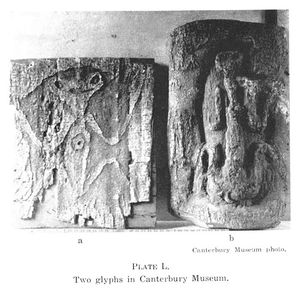Difference between revisions of "Dendroglyphs of the Chatham Islands"
| Line 12: | Line 12: | ||
*Trees | *Trees | ||
*Weapons and fashioned objects | *Weapons and fashioned objects | ||
| − | + | [[Image:Oldpicglyphs.jpg|thumb|right|Two glyphs in the Canterbury Museum]] | |
Of these categories, the human figure is the most common. Their purpose was thought to be commemorative, though the evidence for this is sparse this theory does not explain the plant and animal representations. | Of these categories, the human figure is the most common. Their purpose was thought to be commemorative, though the evidence for this is sparse this theory does not explain the plant and animal representations. | ||
Revision as of 14:50, 23 February 2010
History
The dendroglyphs (tree carvings) of the Chatham Islands were first cataloged in depth by Christina Jefferson between 1947 and 1956 at the urging of her advisor at the Canterbury Museum. Jefferson attempted the first complete record of these dwindling artifacts of Morioriculture.
The Moriori were a Polynesian people who migrated to the Chatham Islands sometime before 1500 and adapted a hunter-gatherer lifestyle and a culture unique to the island chain. Part of their culture included the art of momori rakau, or tree-carving, where human or other natural features were portrayed via incisions into the trunks of live kopi (karaka) trees. The purpose of these carvings is unknown, but a popular speculation is that the carvings were to commemorate ancestors or communicate with otherworldly spirits. A substantial number of the dendroglyphs survive in the JM Barker (Hapupu) Historic Reserve, where they are protected from livestock grazing and souvenir hunters. Still, the carvings are being lost to tree growth and weathering, so the record of these artifacts is all that will survive for future generations.Jefferson's Record
Christina Jefferson began cataloging the dendroglyphs in 1947 and continued writing on the subject until 1956. In this time, she cataloged 450 previously unrecorded glyphs from many different locations on the island and in 1955, she published "The Dendroglyphs of the Chatham Islands" in the Journal of the Polynesian Society. In this paper, she grouped the carvings into four general categories:- Human figures
- Zoomorphic representations
- Trees
- Weapons and fashioned objects
Of these categories, the human figure is the most common. Their purpose was thought to be commemorative, though the evidence for this is sparse this theory does not explain the plant and animal representations.


